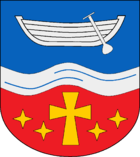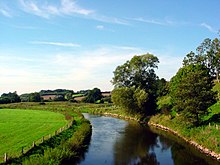Barnitz
| coat of arms | Germany map | |
|---|---|---|

|
Coordinates: 53 ° 48 ' N , 10 ° 30' E |
|
| Basic data | ||
| State : | Schleswig-Holstein | |
| Circle : | Stormarn | |
| Office : | Nordstormarn | |
| Height : | 18 m above sea level NHN | |
| Area : | 11.8 km 2 | |
| Residents: | 863 (Dec. 31, 2019) | |
| Population density : | 73 inhabitants per km 2 | |
| Postal code : | 23858 | |
| Area code : | 04533 | |
| License plate : | OD | |
| Community key : | 01 0 62 008 | |
| Office administration address: | Am Schiefen Kamp 10 23858 Reinfeld (Holstein) |
|
| Website : | ||
| Mayor : | Hans-Joachim Schütt (KWV) | |
| Location of the municipality of Barnitz in the Stormarn district | ||
Barnitz ( Low German Barns ) is a municipality in the Stormarn district in Schleswig-Holstein . The community is located east of Bad Oldesloe and consists of the villages of Benstaben, Groß Barnitz, Klein Barnitz and Lokfeld.
geography
The villages of the municipality lie along the river Trave in a picturesque river valley. This landscape was designed in the late Ice Age as a ground or terminal moraine area , where earth material was left behind after the snowmelt, which the glaciers pushed in front of them. As in the entire eastern part of Schleswig-Holstein, the so-called hill country. The soil therefore consists largely of glacial till , some of which contain quite large boulders. In some places there are more sandy or clayey soils. The soil is extremely fertile and offers the best conditions for general agricultural use as well as for creative gardening and landscaping.
history
The community was established in 1970 as a merger of the previously independent communities Groß Barnitz, Klein Barnitz and Lokfeld. This merger was planned as early as 1938, but it failed. On January 1, 1978, the neighboring town of Benstaben was incorporated.
The place name is probably Wendish, that is, of West Slavic origin. The meaning has not been finally clarified. On the one hand, the name could indicate the establishment by a 'Berislav' as the local founder, but it is more likely that the name was derived from the description of the local situation. Literally translated into High German, 'Barnitz' means something like 'Birken-Au', which indicates a river valley with birch trees. A total of three places and a small river in the former Wendish area bear this name.
A direct connection with the Barnitz River , which flows into the Beste near Bad Oldesloe and then continues with the Trave as Beste, cannot necessarily be derived despite the relative spatial proximity. As far as can be traced in our historiography, the Trave has always given its name to the common further course of the water.
Evidence for earlier settlements in this area is a Stone Age urn cemetery discovered in the 1970s near the 'Heidberg' settlement (1 km east of Barnitz) and a sacrificial stone with two characters and a blood channel in the form of a lightning bolt in Lokfeld. The characters clearly show the influence of the Phoenician script, from which the later and independent runic script developed.
- Benstaben
Benstaben was first mentioned in 1263. At that time it belonged to the Lübeck cathedral chapter . From 1352 to 1582 the village belonged to the Reinfeld monastery , after which it was administered by the old rulership of Reinfeld . When the lordly office of Rethwisch was formed in 1671, Benstaben was placed there. In 1761 serfdom was lifted. After the introduction of the Prussian municipal constitution in 1889, the place belonged to the new district of Rethwisch . In 1948 he became part of the Reinfeld-Land office to be assigned to the Nordstorman office in 1972 . When it was incorporated into Barnitz on January 1, 1978, Benstaben had 176 inhabitants.
- Great Barnitz
Groß Barnitz was founded around 1200 as part of the German northeastern settlement. In the 13th century it belonged to the Lübeck cathedral chapter , since the Reformation it was owned by the Lübeck Johannis monastery as the so-called Lübsches Stadtstiftsdorf . A village school was founded in 1672, and in 1938 the school operation was discontinued in favor of a comprehensive school association in which the communities of Groß Barnitz, Klein Barnitz and Lokfeld participated. From then on, the place of instruction was Lokfeld. After 1964, only elementary school pupils were taught there, and the pupils went to secondary school, secondary school or grammar school in Reinfeld , Bad Oldesloe or Lübeck.
With the secularization in 1803, Groß Barnitz came to the Principality of Lübeck and in 1842 through an exchange of territory to Holstein and there to the rulership of Rethwisch . After the annexation of Schleswig-Holstein by Prussia and the introduction of the municipal constitution in 1889, the place belonged to the district of Klein Wesenberg . In 1948, Groß Barnitz was assigned to the newly established office of Nordstormarn . In 1961 Groß Barnitz had 230 inhabitants.
- Klein Barnitz
Klein Barnitz was first mentioned as Bernice around 1170 and was founded by Wendish . In 1233 it was donated to the Lübeck cathedral chapter . Since 1571 Klein Barnitz was Protestant-Lutheran . Like all properties of the Lübeck Cathedral Chapter outside the city, it belonged to the Principality of Lübeck , and from 1803 to the Principality of Lübeck .
In 1842, Klein Barnitz came to Holstein as part of an area swap and was assigned to the lordly office of Rethwisch . The school, founded in 1680, was merged with Groß Barnitz in 1843 in a community school. After the annexation of Schleswig-Holstein by Prussia , the place was incorporated into the newly founded Stormarn district and since the introduction of the Prussian municipal constitution in 1889 it belonged to the Klein Wesenberg district . The municipal reorganization in 1948 led to the incorporation into the Reinfeld-Land office . In 1961 Klein Barnitz had 61 inhabitants.
- Lokfeld
Lokfeld was first mentioned in a document in 1189. The village comprises a town center with 40 houses and four courtyards in the 'Heckkaten'. These include twelve combined residential and farm buildings, five old parts , a former school, an old forge, a former construction company and a former pub. Two of the other twenty-four pure residential buildings still have separate stables, which are now used as storage or hobby rooms, as in the combined residential / farm buildings. As of January 2006, there were 112 residents registered in Lokfeld, a total of 128 people live there with the children. Most of the usable areas are leased, but commercial agriculture in the sense of arable farming or livestock farming is no longer practiced in Lokfeld, but there are some riding horses.
politics
Municipal council and mayor
Of the eleven seats in the municipal council has the Wählergemeinschaft KWV since the local elections in 2018 five seats, the voter community BFB has two and the CDU four seats.
Mayor is Hans-Joachim Schütt (KWV).
coat of arms
Blazon : “Divided by blue and red by a wide silver wavy bar. Above a silver flat-bottomed boat, below a golden straight-armed paw cross with an extended lower cross arm, accompanied on the right and left by two four-pointed golden stars. "
Culture and sights
Theaters and museums
A revival of cultural life in the community can be seen in several guest performances such as that of the Lübeck Operetta in the Country in the Festsaal in Groß Barnitz, some visual artists have also settled in the village who offer exhibitions, concerts and film evenings. Traditional-cultural events and festivals, rural and handicrafts and also the Low German amateur theater group faded more and more into the background. In winter 2006 the TraveArt e. V. founded by artists, entrepreneurs and private individuals from four federal states in Barnitz to promote regional, national and international art and cultural projects.
Regular events
Traditionally, bird shooting takes place in summer . Young and old from the community take part in the event, whether as a spectator, organizer or participant. It is a welcome opportunity to talk to the neighbors again, with whom you have less to do over the year.
The volunteer fire brigades organize several activities each year such as B. barbecues, lantern parades for the children and a big fir tree burning. The fire brigades also take part in other events, such as B. bird shooting, through support in the construction and dismantling and thus maintain the village cohesion significantly.
Every year on Ascension Day, the local artists open their studios and exhibition rooms to visitors for four days as part of the KunstHandFest Barnitz and present their work and that of a growing number of guest artists from Germany and Europe.
Economy and Infrastructure
Companies
There are only a few farms left in the municipality. The Plakos publisher based in Barnitz.
Public facilities
Barnitz has two volunteer fire departments in Barnitz and Benstaben. The FF Barnitz (formerly: FF Barnitz-Lokfeld) was founded in 1881 and is one of the oldest fire departments in the Stormarn district. The voluntary fire brigades between the community of Barnitz and the city of Schlitz in the Vogelsbergkreis have been on friendly terms for decades.
education
Barnitz has been a member of the Reinfeld School Association since 1972. There is no longer a school in town.
traffic
The federal highway 1 from Hamburg to Lübeck touches the municipality between Benstaben and Klein Barnitz, the next driveway is Reinfeld (3 km). The next train station is also in Reinfeld. A foot and bike path leads to Reinfeld, on which it takes about half an hour to walk from Groß Barnitz via Lokfeld to Reinfeld, and about a quarter of an hour by bike. The villages are about 10 km from Bad Oldesloe, 50 km from Hamburg and 17 km from Lübeck. There are two bridges for road traffic over the Trave, in Benstaben and between Groß Barnitz and Lokfeld. There is a pedestrian bridge near Klein Barnitz. In each district there is a bus stop, from where, on the one hand, the students are brought to the schools in Reinfeld or Bad Oldesloe, and on the other hand, there are also bus connections in the mornings and afternoons to the cities of Lübeck and Bad Oldesloe, which can be used by everyone.
Web links
Individual evidence
- ↑ North Statistics Office - Population of the municipalities in Schleswig-Holstein 4th quarter 2019 (XLSX file) (update based on the 2011 census) ( help on this ).
- ↑ Aasbüttel - Bordesholm . In: Wolfgang Henze (ed.): Schleswig-Holstein topography: cities and villages of the country . 1st edition. tape 1 . Flying-Kiwi-Verl. Junge, Flensburg 2001, ISBN 3-926055-58-8 , p. 228 .
- ^ Federal Statistical Office (ed.): Historical municipality directory for the Federal Republic of Germany. Name, border and key number changes in municipalities, counties and administrative districts from May 27, 1970 to December 31, 1982 . W. Kohlhammer GmbH, Stuttgart and Mainz 1983, ISBN 3-17-003263-1 , p. 187 .
- ↑ Schleswig-Holstein's municipal coat of arms



